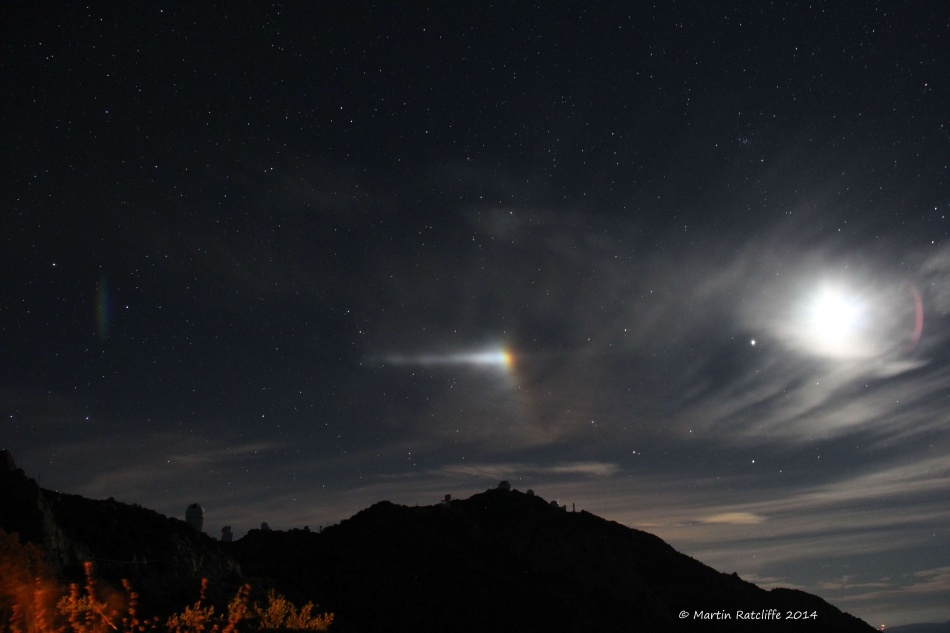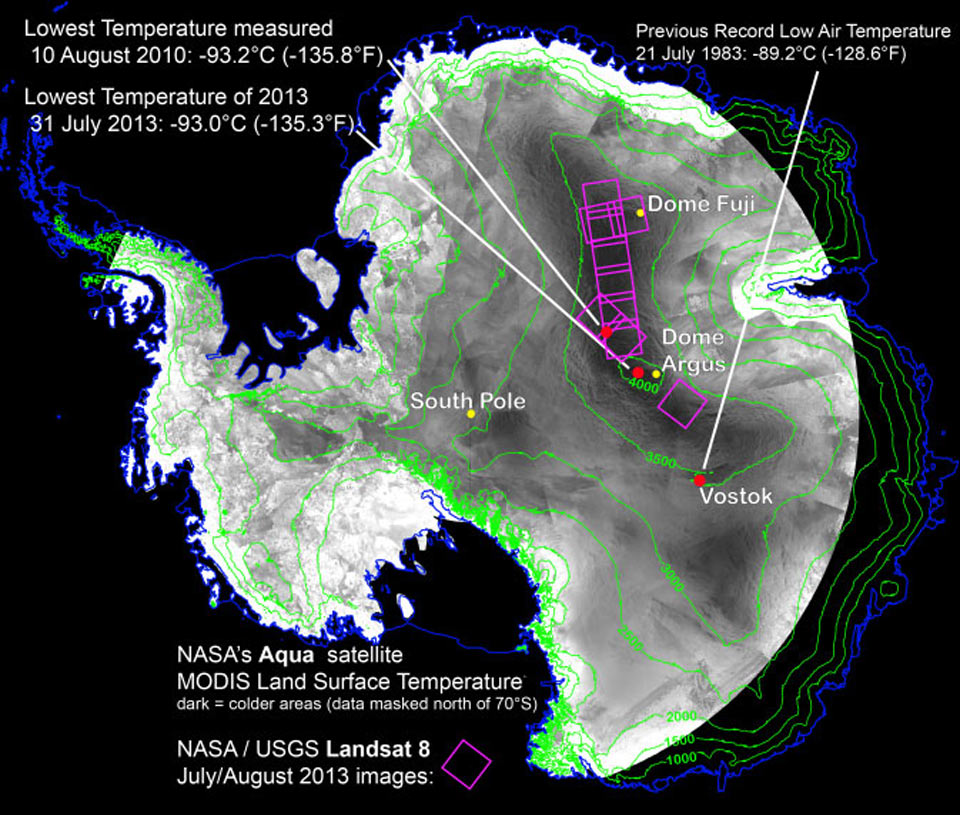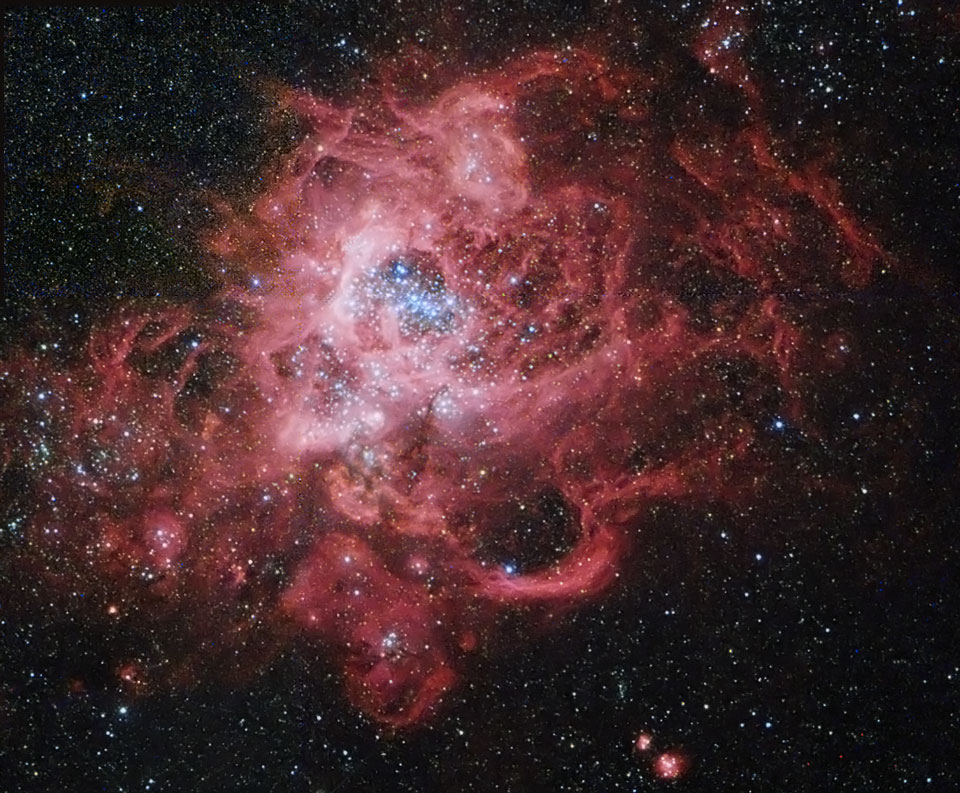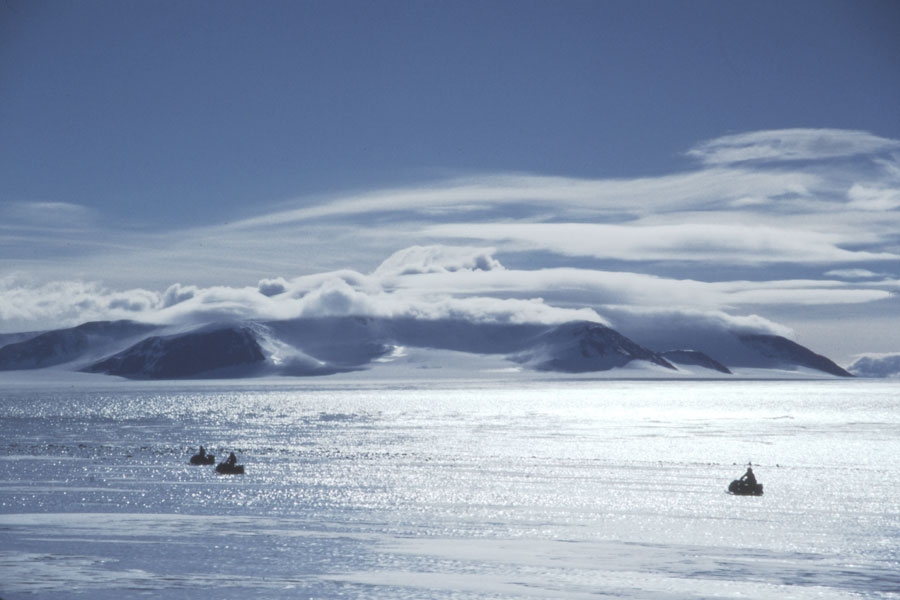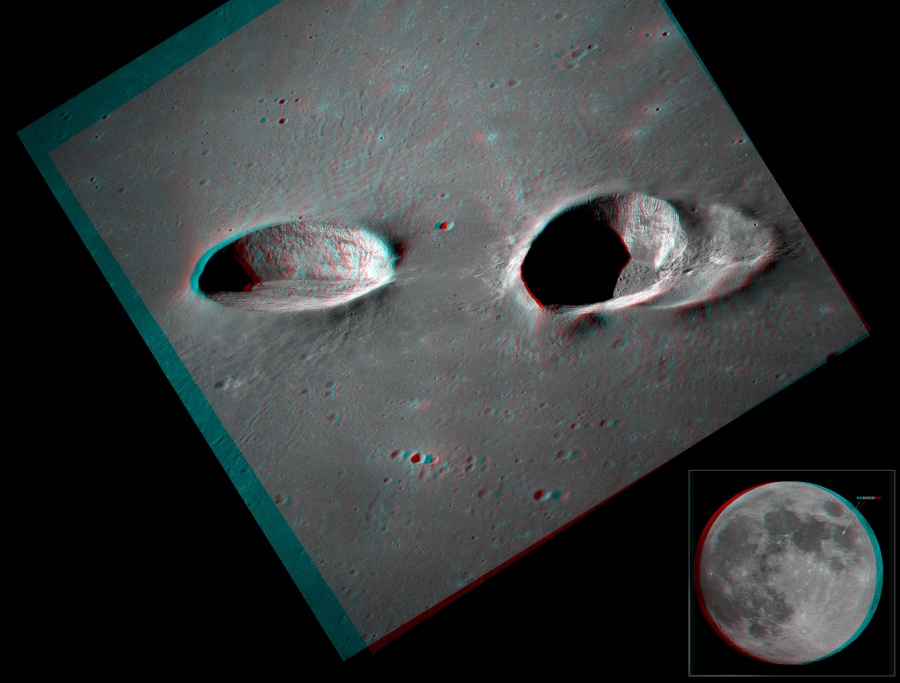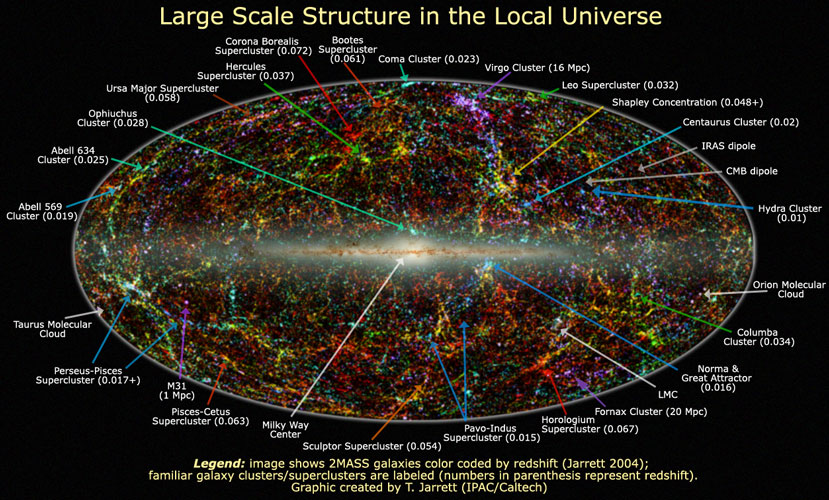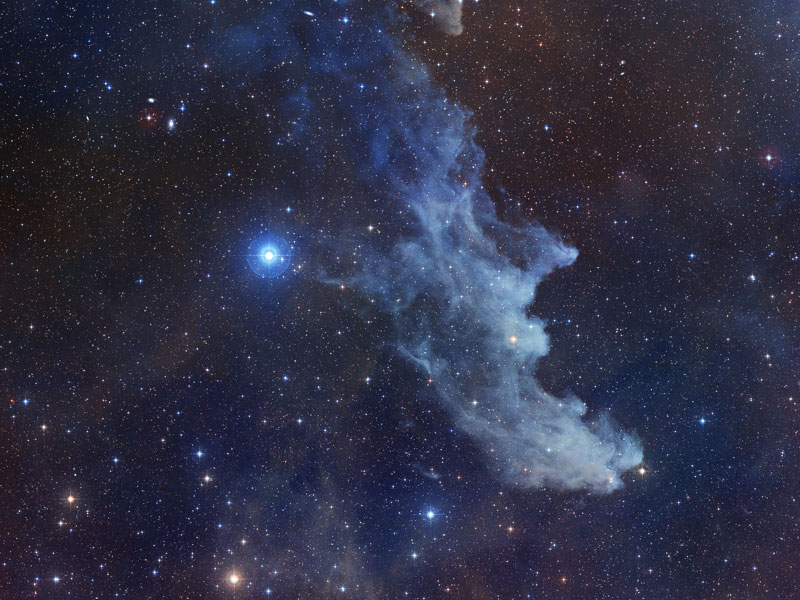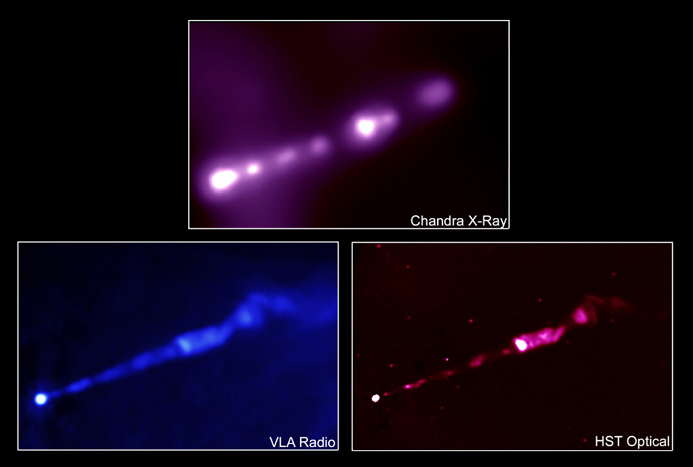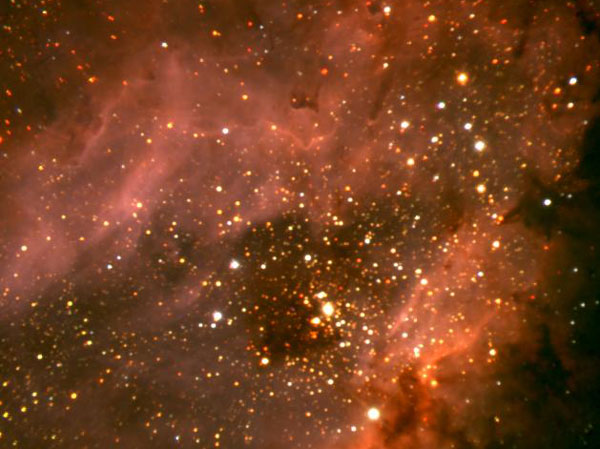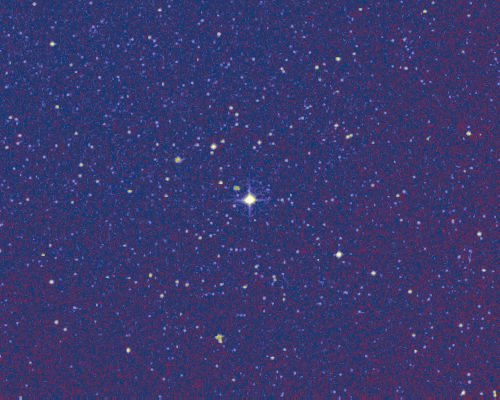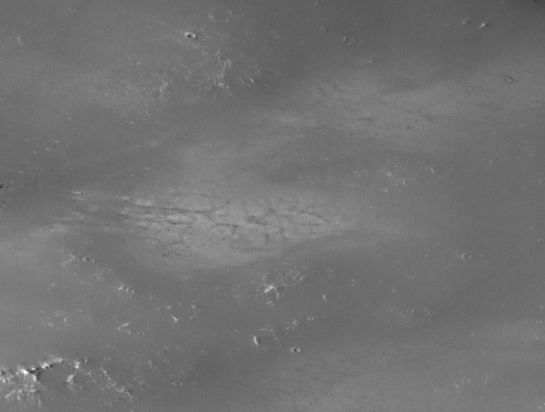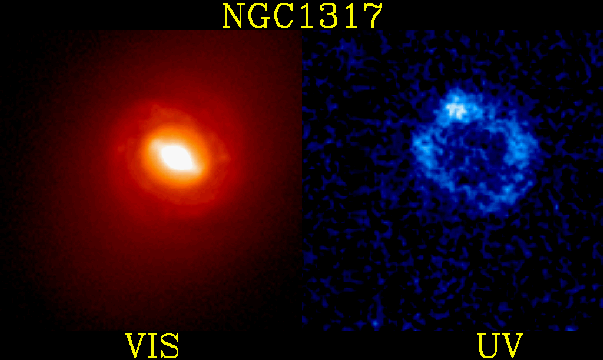| << Previous | Index | Next >> |
2014 In this night scene from the early hours of November 14, light from a last quarter Moon illuminates clouds above the mountaintop domes of Kitt Peak National Observatory near Tucson, Arizona. Bright Jupiter is just left of the overexposed lunar disk with a streak of camera lens flare immediately to the right, but that's no fireball meteor exploding near the center of the picture. Instead, from the roadside perspective a stunningly bright moondog or paraselene stands directly over Kitt Peaks's WIYN telescope. Analogous to a sundog or parhelion, a paraselene is produced by moonlight refracted through thin, hexagonal, plate-shaped ice crystals in high cirrus clouds. As determined by the crystal geometry, paraselenae (plural) are seen at an angle of 22 degrees or more from the Moon. Compared to the bright lunar disk they are more often faint and easier to spot when the Moon is low. About 10 minutes after the photograph even this bright moondog had faded from the night.
2013 How cold can it get on Earth? In the interior of the Antarctica, a record low temperature of -93.2 °C (-135.8 °F) has been recorded. This is about 25 °C (45 °F) colder than the coldest lows noted for any place humans live permanently. The record temperature occurred in 2010 August -- winter in Antarctica -- and was found by scientists sifting through decades of climate data taken by Earth-orbiting satellites. The coldest spots were found near peaks because higher air is generally colder, although specifically in depressions near these peaks because relatively dense cold air settled there and was further cooled by the frozen ground. Summer is a much better time to visit Antarctica, as some regions will warm up as high as 15 °C (59 °F).
2012 Stars are sometimes born in the midst of chaos. About 3 million years ago in the nearby galaxy M33, a large cloud of gas spawned dense internal knots which gravitationally collapsed to form stars. NGC 604 was so large, however, it could form enough stars to make a globular cluster. Many young stars from this cloud are visible in the above image from the Hubble Space Telescope, along with what is left of the initial gas cloud. Some stars were so massive they have already evolved and exploded in a supernova. The brightest stars that are left emit light so energetic that they create one of the largest clouds of ionized hydrogen gas known, comparable to the Tarantula Nebula in our Milky Way's close neighbor, the Large Magellanic Cloud.
2011
2010 Created as planet Earth sweeps through dusty debris from mysterious, asteroid-like, 3200 Phaethon, the annual Geminid Meteor Shower should be the best meteor shower of the year. The Geminids are predicted to peak on the night of December 13/14, but you can start watching for Geminid meteors this weekend. The best viewing is after midnight in a dark, moonless sky, with the shower's radiant constellation Gemini well above the horizon - a situation that favors skygazers in the northern hemisphere. In this picture from the 2009 Geminid shower, a bright meteor with a greenish tinge flashes through the sky over the Mojave Desert near Barstow, California, USA. Recognizable in the background are bright stars in the northern asterism known as the Big Dipper, framing the meteor streak.
2009 Many bright nebulae and star clusters in planet Earth's sky are associated with the name of astronomer Charles Messier, from his famous 18th century catalog. His name is also given to these two large and remarkable craters on the Moon. Standouts in the dark, smooth lunar Sea of Fertility or Mare Fecunditatis, Messier (left) and Messier A have dimensions of 15 by 8 and 16 by 11 kilometers respectively. Their elongated shapes are explained by an extremely shallow-angle trajectory followed by the impactor, moving left to right, that gouged out the craters. The shallow impact also resulted in two bright rays of material extending along the surface to the right, beyond the picture. Intended to be viewed with red/blue glasses (red for the left eye), this striking stereo picture of the crater pair was recently created from high resolution scans of two images (AS11-42-6304, AS11-42-6305) taken during the Apollo 11 mission to the moon.
2008
2007 What does the universe nearby look like? This plot shows over one and a half million of the brightest stars and galaxies in the nearby universe detected by the Two Micron All Sky Survey (2MASS) in infrared light. The resulting image is an incredible tapestry of stars and galaxies that provides limits on how the universe formed and evolved. Across the center are stars that lie in the plane of our own Milky Way Galaxy. Away from the Galactic plane, vast majority of the dots are galaxies, color coded to indicate distance, with blue dots representing the nearest galaxies in the 2Mass survey, and red dots indicating the most distant survey galaxies that lie at a redshift near 0.1. Named structures are annotated. Many galaxies are gravitationally bound together to form clusters, which themselves are loosely bound into superclusters, which in turn are sometimes seen to align over even larger scale structures.
2006 Double, double toil and trouble; Fire burn, and cauldron bubble -- maybe Macbeth should have consulted the Witch Head Nebula. This suggestively shaped reflection nebula is associated with the bright star Rigel in the constellation Orion. More formally known as IC 2118, the Witch Head Nebula glows primarily by light reflected from bright star Rigel, located just off the upper right edge of the full image. Fine dust in the nebula reflects the light. The blue color is caused not only by Rigel's blue color but because the dust grains reflect blue light more efficiently than red. The same physical process causes Earth's daytime sky to appear blue, although the scatterers in Earth's atmosphere are molecules of nitrogen and oxygen. The nebula lies about 1000 light-years away.
2005
2004
2003 From planet Earth, we view this strongly interacting pair of galaxies, cataloged as Arp 81, as they were only about 100 million years after their mutual closest approach. The havoc wreaked by gravity during their ominous encounter is detailed in this color composite image from the Hubble Space Telescope, showing twisted streams of gas and dust, a chaos of massive star formation, and a tidal tail stretching for 200 thousand light-years or so as it sweeps behind the cosmic wreckage. Also known as NGC 6622 (left) and NGC 6621, the galaxies are roughly equal in size but are destined to merge into one large galaxy in the distant future, making repeated approaches until they finally coalesce. Located in the constellation Draco, the galaxies are 280 million light-years away. The dark vertical band which seems to run through NGC 6621's location is a camera artifact.
2002 Streaking high above diffuse clouds -- but well in front of distant stars -- are sand-sized bits of an ancient comet: meteors. These bits flaked off Comet Tempel-Tuttle during its pass through the inner Solar System about 150 years ago. Far in the background are stars toward the constellation of Ursa Major. The above image is digital combination of 12 exposures taken on the morning of November 19 from Florida, USA. Observers there reported a strong peak in faint meteors between 5:30 and 6:00 EST, with a particularly strong minute coming at 5:46 EST when 22 Leonid meteors were counted. The likely less impressive Geminid meteor shower will peak over the next three nights.
2001 Venus, second planet from the Sun, appears above imaged for the first time ever in x-rays (left) by the orbiting Chandra Observatory. Chandra's smoothed, false-color, x-ray view is compared to an optical image (right) from a small earthbound telescope. Both show Venus illuminated by the Sun from the right, with only half the sunward hemisphere visible, but at least one striking difference is apparent. While the optical image in reflected sunlight is filled and bright at the center, Venus in x-rays is bright around the edge. Venus' x-rays are produced by fluorescence rather than reflection. About 120 kilometers or so above the surface, incoming solar x-rays excite atoms in the Venusian atmosphere to unstable energy levels. As the atoms rapidly decay back to their stable ground states they emit a "fluorescence" x-ray, creating a glowing x-ray half-shell above the sunlit hemisphere. More x-ray emitting material can be seen looking at the edge of the shell, so the edge appears brighter in the x-ray image.
2000 The Omega Nebula is a massive, complex cloud of dust and gas from which new stars are continually forming. The similarity to the Greek letter capital Omega gives the molecular cloud its popular name, but the nebula is also known as the Swan Nebula, the Horseshoe Nebula, and M17. Detailed features such as thin filaments of emission by diffuse dust and dark clouds of absorption by dense dust are visible in this recently released picture. The image highlights infrared light emitted by large molecules known as polycyclic aromatic hydrocarbons (PAHs), a gas similar to car exhaust that traces carbon and interstellar dust. PAHs may be an intermediate step between smaller molecules and large interstellar dust grains. The origin of PAHs is currently unknown but thought by some astronomers to form in the cool atmospheres of young carbon stars and to be dispersed by their stellar winds.
1999 The unassuming star centered in this sky view will one day be our next door stellar neighbor. The faint 9th magnitude red dwarf, currently 63 light-years away in the constellation Ophiucus, was recently discovered to be approaching our Solar System. Known in catalogs of nearby stars as Gliese 710 it is predicted to come within 1 light-year of the Sun ... a million years from now. At that distance this star, presently much too faint to be seen by the naked eye, will blaze at 0.6 magnitude - rivaling the apparent brightness of the mighty red giant Antares. Ultimately Gliese 710 poses no direct collision danger itself although its gravitational influence will likely scatter comets out of the Solar System's reservoir, the Oort cloud, sending some inbound. This future stellar encounter was discovered by researchers Joan Garcia-Sanchez and Robert Preston (JPL), and collaborators while studying stars in the solar neighborhood using data from the Hipparcos Astrometry Satellite. The star field shown is based on the Palomar Digitized Sky Survey and is 1/4 degree wide (about half the diameter of the full moon).
1998
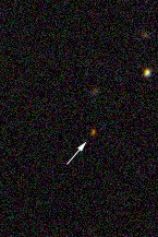
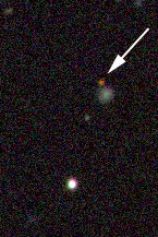
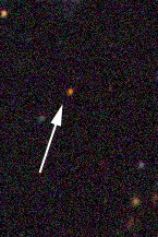
Credit: Sloan Digital Sky Survey
1997 Look closely. In this Mars Global Surveyor image of the Martian surface just south of Schiaparelli crater, dark lines appear to criss-cross light colored depressions. One tantalizing possibility is simply that the feature near the center is similar to a dried-up lake bed on planet Earth, where light colored mineral deposits are left as water evaporates and cracks are produced as the ground dries. This potential Martian lake bed is roughly 3/4 miles across and may provide further evidence that Mars once possessed surface water. Recently announced results from the Mars Pathfinder mission also point to a Martian past which included a denser atmosphere and surface water - conditions which could have supported life.
1996 Where do stars form? A typical place is an area of dense nebular gas common to arms in spiral galaxies. Sometimes, however, a burst of star formation can occur with unusual geometry. Nearby galaxy NGC 1317 shows such an unusual ring of star formation surrounding its barred nucleus. In the above image, older stars appear more red and are more evident in the leftmost photograph in visible light. The rightmost photograph taken by the Ultraviolet Imaging Telescope is in ultraviolet and highlights stars which are younger and bluer and shows the starbirth ring. This unusual ring may be evidence of a gravitational encounter with another galaxy, causing a density wave to ripple out from the galaxy's center.
1995
| << Previous | Index | Next >> |
